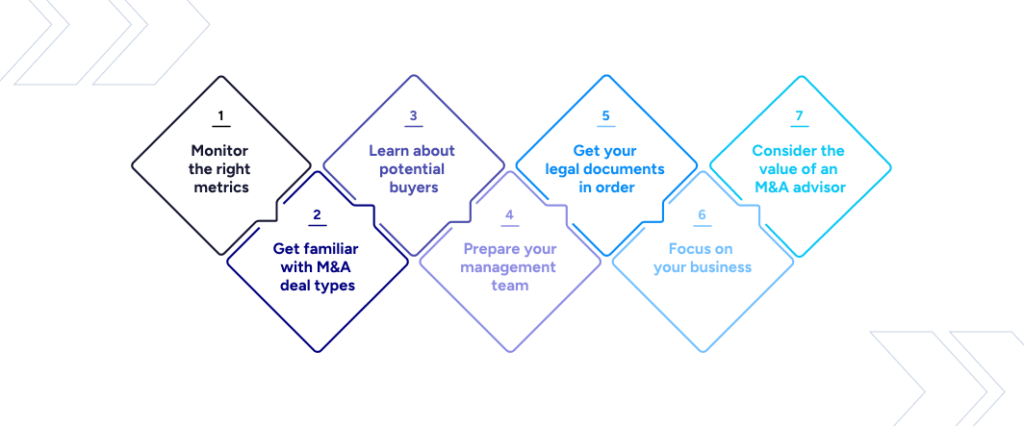- Company
Featured Resource
CLIENT STORYModern Message
To Real Estate
Giant RealPage
- Sectors
Featured Industry Report
EXPERT SERIESManufacturing Software
Report – Part 2
- Research
Featured Resource
FEATURED REPORTThe SEG 2024
Annual SaaS Report
- Tools
Featured Resource
WHITEPAPER20 Factors to Track When Valuing Your
SaaS Company
- Blog
Divestiture Strategy: 5 Simple Steps to Ensure a Seamless Separation

Even when a divestiture makes sense for your business, the actual strategy of parting with an asset can be a lot to process. In many cases, a well executed divestment involves coordinating several moving parts across multiple areas of your company. But despite the amount of work involved, preparing for a divestiture can actually be a great service to the overall health of your business.
In this post we’ll cover the reasons why a business might need to pursue a divestiture, questions to ask when preparing to sell, and then provide a basic game plan to guide you through the process.
Scenarios When Divestment Is a Smart Option
Whether it’s a product line or a small division of a larger company, divesting a portion of a business isn’t always an easy decision, even if all signs point to it being necessary.
That being said, there’s no one single sign every company can look for when considering a divestment. However, there are a handful of common circumstances to keep in mind when evaluating the state of your business.
Eliminating or reducing costs. It’s more productive and financially prudent to sell part of a business than waste valuable resources on something that no longer fits with or serves your company. Any additional funds resulting from the divestiture can be redirected to initiatives or areas of the business that align with the long-term vision for the company.
Cultivating better focus on core competencies. Divestments become more strategic (and some might even say vital) as companies grow. Whether through acquiring IP, creating new product lines, or developing a broad array of services, at some point, a company’s focus can be pulled in too many directions. This can lead to lack of mastery or expertise — essentially, a “jack of all trades, master of none” scenario. A strategic divestiture can help a company regain focus on its core competencies.
Reducing instances of underperformance. Divesting underperforming or unnecessary assets is financially responsible in the long run for both your company and shareholders. A strategic separation can free up vital resources that you can then devote to building on the company’s strengths.
Questions to Ask Before Planning Your Divestiture Strategy
Some companies look for reasons to retain every piece of their business only to later realize how much good it would have done to divest an asset sooner. Avoid this kind of regret by regularly evaluating where your company stands in relation to the market.
In short, ongoing preparation helps you avoid making decisions out of desperation. Here are a few other important questions to consider:
What are your core and non-core businesses, products, or services? Reflecting on why a particular asset originally made sense for your company is key because:
- it helps you develop a rationale for divestment for whatever doesn’t support your core business.
- outlining an asset’s strengths (even if they are no longer strengths for your company) will help your team determine potential buyers who could be a good fit, further expediting the separation process.
What are the asset’s most defining features? You can’t properly market what you can’t define. Knowing an asset’s most important value drivers helps to clearly demonstrate its value and growth potential to buyers.
Current, accurate data and information is crucial to correctly defining and marketing the asset. It clears things up for the buyer, but more importantly, it puts your team in a better position to maximize value and mitigate substantial risk.
Who’s the right buyer? Once you have a full grasp of the asset being sold and its unique value proposition, it’s easier to identify the potential universe of interested buyers. Studying the potential landscape will help to identify and subsequently highlight the asset’s most desirable aspects.
Do you have a team who can work on this endeavor full-time? A dedicated divestiture team streamlines the separation process significantly because they can focus on executing your strategy without being pulled in various directions. The team should include people with big-picture experience who are able to view the pros and cons of the transaction from the perspectives of both seller and buyer.
Timing is (almost) everything
Once you decide that divesting an asset is the right choice, it’s important to move quickly (though prudently; it’s a fine balance). This is why preparing your divestiture strategy is key: a drawn-out separation can decrease the value of the sale, discourage buyers, and result in a less favorable outcome.
For instance, McKinsey & Company reviewed every divestiture valued at $500 million or more from 1992 to 2017 to analyze the effects of prolonged divestments. The results showed “on average, separations completed within 12 months of announcement delivered higher excess TRS [total returns to shareholders] than those that took longer.” Specifically, divestiture strategies executed within 8 to 12 months of announcement resulted in 5.8% excess TRS while those completed within 13-24 months experienced -10.5% TRS.
Your anticipated deal might not meet their study’s $500 million valuation criteria, but completing the deal in a timely fashion is still likely to benefit your employees and investors.
Executing a Successful Divestiture Strategy
Once you’ve defined the asset, surveyed the landscape of possible buyers, and determined you need a divestment, you can begin the plan for separation.
The finer details of a divestiture strategy are bound to differ from company to company. For example, retention figures and unit economics are especially important in SaaS divestitures because they impact the long term profitability of SaaS assets.
Every industry is different; buyers will have their own concerns and requirements, and the ultimate divestment goal of one company could be completely different from one of their competitors. But the following steps can provide general guidance to make the process as clear-cut as reasonably possible.
Step #1 Establish the deal parameters
The scope of the divestiture must be clearly defined before making any announcements or entering into discussions with outside parties. Consult with your divestiture team and trusted experts (advisors, lawyers, etc.) to determine what’s included in the deal. Some areas of consideration include:
- IT infrastructure
- customer contracts
- IP
- personnel
- operations
As the scope of the deal becomes more clear, your team should be able to zero in on the ideal type of buyer.
Step #2 Consult with key advisors and divestiture strategy team
After determining the deal parameters, take a closer look at the asset’s performance as though it were a stand-alone entity. The goal of this analysis is to understand the asset’s current performance and potential future value so well that it takes the guesswork out of the deal for interested parties.
Again, as the strategy team separates out information specifically related to the soon-to-be divested asset, they’ll get a better sense of when the market timing is right. Ideally, they will also be able to advise the company as to whether a broad, public announcement or a personalized approach to a smaller, select group of buyers is the right path for the deal.
Step #3 Organize pertinent information for interested buyers
Detailed plans not only help sellers establish a competitive position; they streamline the divestment process for buyers, as well. The fewer requests buyers need to make for data, customers data, product information, and other relevant information, the more time everyone has to discuss the finer points of making the proposed divestiture a reality.
Organizing materials such as historical customer data and financial statements presenting the asset as a stand-alone entity can help to: 1) lower the perceived risk from the buyer side; and 2) justify a higher value by rationalizing potential risks.
Step #4 Determine how much of the unit is tied to other parts of the business
Earlier, we discussed the importance of moving quickly yet prudently in your divestiture strategy. The “prudently” part comes into play when reviewing how the part of your company you want to divest is tied into the rest of your business. Move too quickly on a deal, and you might find that other parts of the company can’t stand alone or function cohesively without the divested unit.
An interdependency assessment and transition services agreement (TSA) certainly benefit the buyer’s side of a deal, but this information is critical to the seller, too. The research that goes into the assessment and development of a TSA can help you determine what you’ll need to modify or shift on the part of the business you retain.
Regarding TSAs: depending on your situation, this agreement can be extremely useful and make the transition more seamless on the buyer’s side; however, it’s recommended to use TSAs sparingly. The ultimate goal of a successful divestiture is to separate your company from this asset, and a poorly structured TSA can prolong the separation process and strain resources you wanted to alleviate in the first place.
Step #5 Create a divestiture strategy timeline addressing each team’s involvement
Each segment of the divestiture strategy team (sales strategy, operations, etc.) has its own set of actions to follow through the divestment process. Ensure each team is moving at the same or similar pace by creating regular checkpoints. This will help everyone monitor their progress, adjust timeframes, and, if necessary, regroup and make other adjustments.
Although divestiture strategies require a substantial amount of planning and coordination, they can ultimately be a great service to your company. Regularly assessing your business, keeping accurate financial records, and working with a team you trust can make something as complex as divestment more of an opportunity than a challenge.







